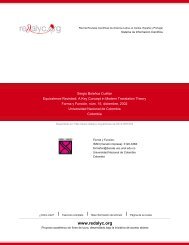Portraits of the spiritual Seeing in Mark's Gospel. Origen ... - Redalyc
Portraits of the spiritual Seeing in Mark's Gospel. Origen ... - Redalyc
Portraits of the spiritual Seeing in Mark's Gospel. Origen ... - Redalyc
You also want an ePaper? Increase the reach of your titles
YUMPU automatically turns print PDFs into web optimized ePapers that Google loves.
Teología y Vida, Vol. LIV (2013), 307-337<br />
307<br />
Jesus and <strong>the</strong> Demons: <strong>Portraits</strong> <strong>of</strong> <strong>the</strong> <strong>spiritual</strong> <strong>See<strong>in</strong>g</strong> <strong>in</strong> Mark’s<br />
<strong>Gospel</strong>. <strong>Origen</strong>, Bonaventure and Ignatius as hermeneutic read<strong>in</strong>g<br />
key <strong>of</strong> <strong>the</strong> <strong>Gospel</strong><br />
Dempsey Rosales-Acosta<br />
UNIVERSITY OF ST. THOMAS<br />
HUSTON-TEXAS<br />
1. The hermeneutic key: <strong>the</strong> Spiritual Senses<br />
The expression «<strong>spiritual</strong> sense» is per se a paradox. The spirit by its proper<br />
essence subsists <strong>in</strong>dependently from <strong>the</strong> body, and from <strong>the</strong> sensorial means<br />
that <strong>the</strong> body needs to communicate <strong>in</strong>teractively with <strong>the</strong> surround<strong>in</strong>g<br />
world. In antiquity, already <strong>the</strong> platonic ideas conceive <strong>the</strong> entity <strong>of</strong> <strong>the</strong><br />
spirit as an entity that needs to liberate itself from <strong>the</strong> body and all its<br />
functions <strong>in</strong> order to achieve its own perfection, namely to be what its<br />
nature suppose to be, free from <strong>the</strong> trap <strong>of</strong> <strong>the</strong> corporeal human body.<br />
Therefore where or how is it possible to justify such paradox?<br />
The notion <strong>of</strong> <strong>the</strong> <strong>spiritual</strong> senses <strong>in</strong> Christianity connects itself<br />
strictly to <strong>the</strong> event <strong>of</strong> <strong>the</strong> Incarnation <strong>of</strong> Christ. Such event concretizes<br />
<strong>the</strong> notion that <strong>the</strong> <strong>in</strong>visibility <strong>of</strong> <strong>the</strong> <strong>spiritual</strong> world <strong>of</strong> God becomes a<br />
sensory experience that emphasizes <strong>the</strong> bodily senses <strong>in</strong>stead <strong>of</strong> reject<strong>in</strong>g<br />
<strong>the</strong>m.<br />
The Logos through his Incarnation assumes <strong>the</strong> humanity, manifest<strong>in</strong>g<br />
and reveal<strong>in</strong>g <strong>the</strong> mystery <strong>of</strong> God without <strong>the</strong> confus<strong>in</strong>g or mix<strong>in</strong>g <strong>of</strong> his<br />
two natures: div<strong>in</strong>e and human. This means that <strong>the</strong> humanity <strong>of</strong> Christ<br />
is an <strong>in</strong>strument or channel <strong>of</strong> communication <strong>of</strong> <strong>the</strong> div<strong>in</strong>e mystery,<br />
namely, his flesh is not <strong>the</strong> div<strong>in</strong>ity itself s<strong>in</strong>ce <strong>the</strong> human nature is<br />
not absorbed by <strong>the</strong> div<strong>in</strong>e nature 1 . Thus <strong>the</strong> humanity assumed by <strong>the</strong><br />
1<br />
The def<strong>in</strong>ition <strong>of</strong> <strong>the</strong> Council <strong>of</strong> Chalcedon (451 AD) confirms this statement:<br />
«Therefore, follow<strong>in</strong>g <strong>the</strong> holy fa<strong>the</strong>rs, we all with one accord teach men to<br />
acknowledge one and <strong>the</strong> same Son, our Lord Jesus Christ, at once complete <strong>in</strong>
















